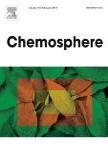版权所有:内蒙古大学图书馆 技术提供:维普资讯• 智图
内蒙古自治区呼和浩特市赛罕区大学西街235号 邮编: 010021

作者机构:Environmental Protection Key Laboratory of Microorganism Application and Risk Control Guangdong Provincial Engineering Research Center for Urban Water Recycling and Environmental Safety Institute of Environment and Ecology Tsinghua Shenzhen International Graduate School Tsinghua University Shenzhen518055 China Environmental Engineering and Science Program Department of Chemical and Environmental Engineering University of Cincinnati CincinnatiOH45221 United States Department of Environmental Engineering and Earth Science Clemson University SC29634 United States
出 版 物:《Chemosphere》 (Chemosphere)
年 卷 期:2024年第349卷
页 面:140807页
核心收录:
学科分类:0830[工学-环境科学与工程(可授工学、理学、农学学位)] 070902[理学-地球化学] 0709[理学-地质学] 0817[工学-化学工程与技术] 08[工学] 0815[工学-水利工程] 0703[理学-化学]
基 金:This study was supported by the National Key R&D Program of China (No. 2022YFE0104900 ) National Natural Science Foundation of China (No. 52022049 / 51978370 ) China Postdoctoral Science Foundation (No. 2021M691776 ) and the Shenzhen Science Technology and Innovation Commission (No. JCYJ20220818101010022 )
主 题:Chlorination
摘 要:Permanganate is a common preoxidant applied in water treatment to remove organic pollutants and to reduce the formation of disinfection by-products. However, the effect of permanganate preoxidation on the transformation of dissolved effluent organic matter (dEfOM) and on the formation of unknown chlorinated disinfection by-products (Cl-DBPs) during chlorination remains unknown at molecular level. In this work, the molecular changes of dEfOM during permanganate preoxidation and subsequent chlorination were characterized using Fourier transform ion cyclotron resonance mass spectrometry (FT-ICR MS). Permanganate preoxidation was found to decrease the DBE (double bond equivalent) and AImod (modified aromaticity index) of the dEfOM. The identity and fate of over 400 unknown Cl-DBPs during KMnO4-chlorine treatment were investigated. Most Cl-DBPs and the precursors were found to be highly unsaturated aliphatic and phenolic compounds. The Cl-DBPs precursors with lower H/C and lower O/C were preferentially removed by permanganate preoxidation. Additionally, permanganate preoxidation decreased the number of unknown Cl-DBPs by 30% and intensity of unknown Cl-DBPs by 25%. One-chlorine-containing DBPs were the major Cl-DBPs and had more CH2 groups and higher DBEw than Cl-DBPs containing two and three chlorine atoms. 60% of the Cl-DBPs formation was attributed to substitution reactions (i.e., +Cl–H, +2Cl–2H, +3Cl–3H, +ClO–H, +Cl2O3–2H). This work provides detailed molecular level information on the efficacy of permanganate preoxidation on the control of overall Cl-DBPs formation during chlorination. © 2023 Elsevier Ltd